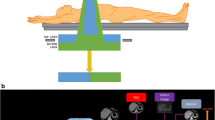Abstract
Objective
Computed tomography (CT) uses radiographical density to depict different materials; although different elements have different absorption fingerprints across the range of diagnostic X-ray energies, this spectral absorption information is lost in conventional CT. The recent development of dual energy CT (DECT) allows extraction of this information to a useful but limited extent. However, the advent of new photon counting chips that have energy resolution capabilities has put multi-energy or spectral CT (SCT) on the clinical horizon.
Methods
This paper uses a prototype SCT system to demonstrate how CT density measurements vary with kilovoltage.
Results
While radiologists learn about linear attenuation curves during radiology training, they do not usually need a detailed understanding of this phenomenon in their clinical practice. However SCT requires a paradigm shift in how radiologists think about CT density.
Conclusion
Because radiologists are already familiar with the Hounsfield Unit (HU), it is proposed that a modified HU be used that includes the mean energy used to obtain the image, as a conceptual bridge between conventional CT and SCT. A suggested format would be: HUkeV.
Key Points
• Spectral computed tomography uses K-edge and slope effects to identify element signatures.
• New visualisation tools will be required to efficiently display spectral CT information.
• This paper demonstrates HU variation with keV using the Medipix3 chip.
• HU keV is a suggested format when stating spectral HU measurements.







Similar content being viewed by others
Notes
A joint project between the CERN Medipix2 Collaboration, Geneva, and the University of Canterbury, New Zealand.
References
Boll DT, Hoffmann MH, Huber N, Bossert AS, Aschoff AJ, Fleiter TR (2006) Spectral coronary multidetector computed tomography angiography: dual benefit by facilitating plaque characterization and enhancing lumen depiction. J Comput Assist Tomogr 30:804–811
Wesarg S, Kafchitsas K, Erdt M, Khan MF (2010) CAD of osteoporosis in vertebrae using dual-energy CT. In: Dillon T (ed) Twenty-Third IEEE Symposium on Computer-Based Medical Systems, CBMS 2010, Perth, Australia, 12–15 October 2010. IEEE Computer Society Press, Los Alamitos, pp 358–363
Watanabe Y, Uotani K, Nakazawa T, Higashi M, Yamada N, Hori Y, Kanzaki S, Fukuda T, Itoh T, Naito H (2009) Dual-energy direct bone removal CT angiography for evaluation of intracranial aneurysm or stenosis: comparison with conventional digital subtraction angiography. Eur Radiol 19:1019–1024
Mahgerefteh S, Blachar A, Fraifeld S, Sosna J (2010) Dual-energy derived virtual nonenhanced computed tomography imaging: current status and applications. Semin Ultrasound CT MR 31:321–327
Graser A, Johnson TR, Chandarana H, Macari M (2009) Dual energy CT: preliminary observations and potential clinical applications in the abdomen. Eur Radiol 19:13–23
Kalender WA, Deak P, Kellermeier M, van Straten M, Vollmar SV (2009) Application- and patient size-dependent optimization of x-ray spectra for CT. Med Phys 36:993–1007
Pan D, Roessl E, Schlomka JP, Caruthers SD, Senpan A, Scott MJ, Allen JS, Zhang H, Hu G, Gaffney PJ, Choi ET, Rasche V, Wickline SA, Proksa R, Lanza GM (2010) Computed tomography in color: NanoK-enhanced spectral CT molecular imaging. Angew Chem Int Ed Engl 122:9829–9833
Cormode DP, Roessl E, Thran A, Skajaa T, Gordon RE, Schlomka JP, Fuster V, Fisher EA, Mulder WJ, Proksa R, Fayad ZA (2010) Atherosclerotic plaque composition: analysis with multicolor CT and targeted gold nanoparticles. Radiology 256:774–782
Badea CT, Johnston SM, Qi Y, Johnson GA, Ghaghada K (2011) Dual-energy micro-CT imaging for differentiation of iodine- and gold-based nanoparticles. Proc SPIE 7961. doi:10.1117/12.878043
Medipix home page. Available via: http://medipix.web.cern.ch/MEDIPIX/. Accessed 14 July 2011
Gimenez EN, Ballabriga R, Campbell M, Horswell I, Llopart X, Marchal J, Sawhney KJS, Tartoni N, Turecek D (2011) Characterization of Medipix3 with Synchrotron Radiation. IEEE Trans Nucl Sci 58:323–332
CT – 2008 data sheet index (7 Apr 2009). Available via: http://www.rt-image.com/datasheet/index.cfm?chartID=85&action=1. Accessed 21 July 2011
Anderson NG, Butler AP, Scott NJA, Cook NJ, Butzer JS, Schleich N, Firsching M, Grasset R, de Ruiter N, Campbell M, Butler PH (2010) Spectroscopic (multi-energy) CT distinguishes iodine and barium contrast material in mice. Eur Radiol 20:2126–2134
Hubbell JH, Seltzer SM (2004) Tables of X-ray mass attenuation coefficients and mass energy-absorption coefficients (version 1.4). [Online] Available: http://physics.nist.gov/PhysRefData/XrayMassCoef/tab3.html (Accessed 7/7/11). National Institute of Standards and Technology, Gaithersburg, MD. Originally published as NISTIR 5632, National Institute of Standards and Technology, Gaithersburg, MD (1995)
Brooks R (1977) A quantitative theory of the Hounsfield unit and its application to dual energy scanning. J Comput Assist Tomogr 1:487–493
Giersch J, Niederlöhner D, Anton G (2004) The influence of energy weighting on X-ray imaging quality. Nucl Instrum Methods Phys Res A 531:68–74
Yeh BM, Shepherd JA, Wang ZJ, Teh HS, Hartman RP, Prevrhal S (2009) Dual-energy and low-kVp CT in the abdomen. AJR Am J Roentgenol 193:47–54
Cann CE, Genant HK (1980) Precise measurement of vertebral mineral-content using computed-tomography. J Comput Assist Tomogr 4(4):493–500, ISSN: 0363–8715
Rutherford RA, Pullan BR, Isherwood I (1976) Measurement of effective atomic number and electron density using an EMI scanner. Neuroradiology 11:15–21
Raptopoulos V, Karellas A, Bernstein J, Reale FR, Constantinou C, Zawacki JK (1991) Value of dual-energy CT in differentiating focal fatty infiltration of the liver from low-density masses. AJR Am J Roentgenol 157:721–725
Acknowledgements
We would like to acknowledge the support for this work from the Medipix 3 Collaboration who developed the Medipix 3 chip. We would also like to acknowledge the significant financial support for the MARS project from the NZ Government FRST Grant (Proj-13860-NMTS-UOC).
Author information
Authors and Affiliations
Corresponding author
Rights and permissions
About this article
Cite this article
Hurrell, M.A., Butler, A.P.H., Cook, N.J. et al. Spectral Hounsfield units: a new radiological concept. Eur Radiol 22, 1008–1013 (2012). https://doi.org/10.1007/s00330-011-2348-3
Received:
Revised:
Accepted:
Published:
Issue Date:
DOI: https://doi.org/10.1007/s00330-011-2348-3




